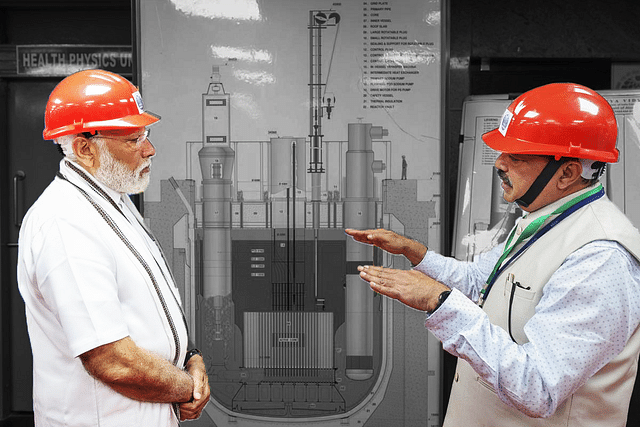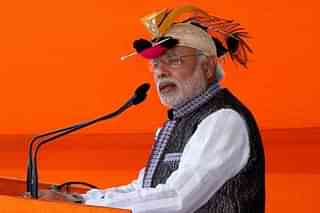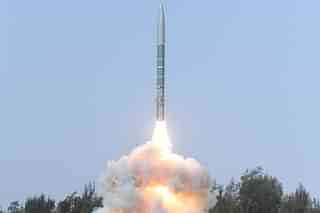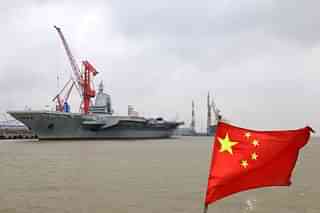Science
India Enters Stage Two Of Its Nuclear Programme; The Three Stages, Explained
Karan Kamble
Mar 07, 2024, 11:13 AM | Updated Mar 08, 2024, 05:03 PM IST
Save & read from anywhere!
Bookmark stories for easy access on any device or the Swarajya app.

This past Monday (4 March), Prime Minister Narendra Modi witnessed the initiation of "core loading" at India's first homegrown “fast breeder reactor” in Kalpakkam, Tamil Nadu.
In a nuclear reactor, core loading is the process of loading nuclear fuel assemblies into the reactor core. The fuel assemblies comprise fuel rods that contain fissile material, such as enriched uranium or plutonium, which undergoes nuclear fission to produce heat.
And a fast breeder reactor is a type of nuclear reactor that is designed to produce more fissile material (such as Plutonium-239) than it consumes during operation.
It achieves this by using fast neutrons to convert non-fissile isotopes (such as Uranium-238) into fissile isotopes (such as Plutonium-239). This process is known as "breeding" because it creates more fissile material than is initially loaded into the reactor.
India’s prototype fast breeder reactor (PFBR) in Tamil Nadu has a capacity of 500 Megawatt electric (MWe). It was designed by the Indira Gandhi Centre for Atomic Research and constructed by BHAVINI.
Short for Bharatiya Nabhikiya Vidyut Nigam Limited, BHAVINI was established in 2003 to build and operate the PFBR.
Over 200 players from the Indian industry have contributed to the PFBR's development. This reactor is considered a precursor to future fast breeder reactors (FBRs).
After the core loading is completed, the Kalpakkam PFBR reactor will undergo the first approach to criticality, leading to power generation.
Once it becomes operational, India will be only the second country after Russia to have a commercial operating fast breeder reactor.
Milestone Unlocked
The latest development symbolises India’s entry into the crucial second stage of the country’s three-stage nuclear programme — as stated in the note put out by The Prime Minister's Office.
India holds only about 1-2 per cent of the world's uranium reserves, but it possesses one of the largest shares of global thorium reserves, estimated at around 25 per cent of the world's known thorium reserves.
Dr Homi Bhabha, therefore, devised a three-stage nuclear power programme to make the most of India's limited uranium reserves and abundant thorium reserves.
Each stage of the programme has fuel cycle linkages. This means that spent fuel from one stage is reprocessed to obtain fuel for the next stage — there is little to no wastage.
Ultimately, the goal is to generate nuclear power while ensuring long-term energy security.
The three stages are:
1) Pressurised heavy water reactors (PHWRs) using natural uranium as fuel
2) FBRs using plutonium as fuel
3) Advanced reactors using Uranium-233 as fuel in a thorium-uranium cycle
The first stage involves using natural uranium in PHWRs to multiply domestically available fissile resources.
Natural uranium consists of 0.7 per cent Uranium-235, which undergoes fission to release energy.
The remaining 99.3 per cent is Uranium-238, which is not fissile but can be converted into the fissile element Plutonium-239 in a nuclear reactor.
In the second stage, plutonium from the spent fuel of PHWRs is used in FBRs, such as the one at Kalpakkam which saw the initiation of core loading on 4 March.
FBRs are fuelled by a mixed oxide of Uranium-238 and Plutonium-239, which is recovered by reprocessing the spent fuel from the first stage.
In FBRs, Plutonium-239 undergoes fission, producing energy and more Plutonium-239 through the transmutation of Uranium-238.
This process allows FBRs to produce energy and additional fuel, which is why they are termed "breeders." FBRs generate more fuel than they consume.
Over time, a stockpile of plutonium can be built up by introducing Uranium-238 into the reactor.
Once enough nuclear capacity is built, the third stage will involve using thorium, which will be converted into Uranium-233 in FBRs.
Thorium-232, which is abundant in India, is not fissile. Therefore, it needs to be converted into a fissile material, Uranium-233, through transmutation in an FBR.
Significant commercial use of thorium can only begin when there are abundant supplies of either Uranium-233 or plutonium.
The conversion fron thorium to uranium is planned to be achieved in the second stage of the programme, which involves the commercial operation of FBRs.
After the PFBR at Kalpakkam becomes operational, BHAVINI will build two 600 MWe FBRs adjacent to it. The preparatory activities are currently in progress.
Three Stages Will Take Time
The third stage, utilising thorium as an energy source, is expected to be reached in a few decades.
Just like with uranium, generating electricity from thorium produces no greenhouse gases, making it a clean energy source.
Thorium reactors are also more cost-effective than conventional reactors.
Nobel laureate Carlo Rubbia estimates that a tonne of thorium could produce as much energy as 200 tonnes of uranium or 4 million tonnes of coal. As a result, far less nuclear waste is generated.
Importantly, the waste from thorium reactors contains no isotopes with a half-life beyond 35 years, significantly reducing the required storage time.
Harnessing thorium for India's energy needs presents many economic opportunities, as argued in Swarajya (2015) by nuclear policy expert Jaideep Prabhu.
The availability of affordable electricity could drive a transition away from gas, petrol, and diesel for cooking and transportation.
Additionally, nuclear energy could alleviate the pressure on the railways by reducing the need to transport millions of tons of coal, potentially reducing the necessity for service expansion.
To prepare for the use of thorium in the third stage of the programme, efforts are currently underway to develop and demonstrate the necessary technology. This is being done so that a mature technology for thorium utilisation will be ready in time.
The Bhabha Atomic Research Centre is developing a 300 MWe advanced heavy water reactor (AHWR).
The AHWR is an innovative concept that serves as a bridge between the first and third stages of the nuclear programme. It aims to advance thorium utilisation without going through the second stage.
The AHWR uses light water as a coolant and heavy water as a moderator. It is fuelled by a mixture of Plutonium-239 and Thorium-232, with a significant portion of the power being generated from Thorium-232.
The "AHWR is not only a stepping stone to the third stage but also expected to provide a platform for developing and testing technologies required for the third stage," according to the Department of Atomic Energy.
The three-stage nuclear programme is expected to make India completely self-sufficient in nuclear energy.
Save & read from anywhere!
Bookmark stories for easy access on any device or the Swarajya app.
Karan Kamble writes on science and technology. He occasionally wears the hat of a video anchor for Swarajya's online video programmes.
Introducing ElectionsHQ + 50 Ground Reports Project
The 2024 elections might seem easy to guess, but there are some important questions that shouldn't be missed.
Do freebies still sway voters? Do people prioritise infrastructure when voting? How will Punjab vote?
The answers to these questions provide great insights into where we, as a country, are headed in the years to come.
Swarajya is starting a project with an aim to do 50 solid ground stories and a smart commentary service on WhatsApp, a one-of-a-kind. We'd love your support during this election season.
Click below to contribute.





